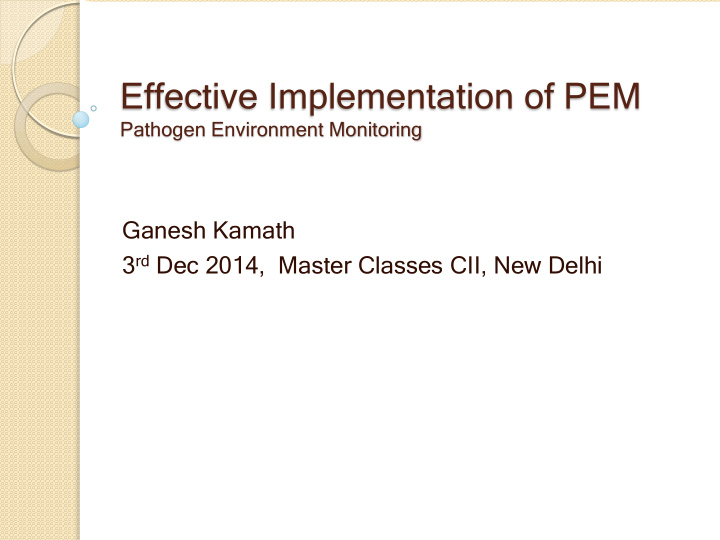



Effective Implementation of PEM Pathogen Environment Monitoring Ganesh Kamath 3 rd Dec 2014, Master Classes CII, New Delhi
To conclude, the take home message is.. 5 messages on PEM Program Understand the Intent Pre-requisites are backbone, know your mistakes Be sure of your target and sampling Listen to the data Manage Adverse events carefully
Understand the Program Is Finished food analysis good enough? ◦ What criteria absent/g, /10g, /25g. / 5x25g??? If so then why this statistics? Microbiology results are based on Number of cases of culture-confirmed bacterial and sampling, probability, extent of laboratory-confirmed parasitic infection, hospitalizations, and deaths, by pathogen — Foodborne Diseases Active Surveillance Network, United States, 2013* contamination, recovery etc So the Intent is ◦ Protect our Consumers ◦ Protect our Business
Understand the Intent What is the intention of this program? ◦ To have a clean data? ◦ To have a clean manufacturing line? ◦ To pass the audits? The intent is ◦ To verify the effectiveness of certain prerequisite programs implemented in the site to assure Microbiological Food Safety ◦ To understand the cause of cross contamination ◦ To establish an early warning system ◦ To Hunt nt and Elim limin inate
Pre-requisites are backbone When to implement the PEM program? Start with Pre-requisite programs First ◦ Zoning ◦ Pest Management ◦ Cleaning and Sanitation ◦ Maintenance practices ◦ Training and people practices
Mistakes in Zoning Do we know our Raw and RTE Areas? ◦ Do we have controlled access from exteriors Is our traffic under control? ◦ Do we move pallets between Areas ◦ Do we move trolleys between Areas ◦ Do we have transition zones How is the air flowing between Areas? Are our buildings and roofs ensure integrity to natural forces? Is our Zoning in RTE correct? ◦ Zone 1 / Zone 2 / Zone 3 / Zone 4
Mistakes in Cleaning and Sanitation Dedicated cleaning tools in Raw and RTE area ◦ Are they colour coded Dedicated tools for different Zones in RTE area ◦ Are they colour coded ◦ Are these tools handled, cleaned and sanitised separately? Dedicated Vacuum cleaners Do we have dedicated cleaning tools for drains Are our RTE areas maintained Bone e Dry ry during production Cleaning of cleaning tools?
Mistakes in maintenance practices Breakdowns ◦ All rules are thrown out of window! Sunday Maintenance ◦ GMP does not apply ◦ Microbiologist / Hygienist on leave ◦ OEM, Contractors have no idea about zoning and PEM Practices RTE area Tools ◦ Is separate maintenance tools used for RTE zones Raw area Tools ◦ What about cleaning after maintenance activities?
Mistakes in People practices Transition zone bypass ◦ Rules are not for me! Cleaning practices ◦ Do it fast, we need to start production ◦ Dry cleaning, what is that? ◦ Untrained contract labour does the cleaning job ◦ Tool control, how does that matter? ◦ Drains the most neglected part of a factory Training and monitoring program
Mistakes in Target Organism What is our Target Pathogen ◦ Salmonella, Listeria, E Coli? ◦ Not TPC, Coliforms and Y&M ◦ Sole dependence of Target Pathogen? Do we use Indicator organism ◦ Enterobacteriaceae (EB) ◦ Do we have action limits? Root cause analysis and Corrective actions? Where do we sample ◦ Line>Zone 1>Zone2>Zone3>Zone4? ◦ Raw Area?
Mistakes in sampling Are we using the right tools and techniques? Targeting conformance! ◦ Sample after cleaning ◦ Sample the same spot over and again Mostly missed hot spots ◦ Focus on items that cross transitions zones (Pallets, forklift wheels, shoes) ◦ Dust bins, Vacuum cleaners ◦ Hunting for dirty, hidden, moist, hard to reach
Mistakes in data analysis Cross contamination Improper Trends… Why? cleaning Do we know the hot spots? Can we trace the exact root cause of cross contamination Major Maintenance
Adverse Event Management What is an adverse event? ◦ Roof leakage ◦ Un controlled water in RTE area ◦ Drain back off etc What should you do? ◦ Isolate the area ◦ Take control of incriminated products ◦ Clean and Disinfect ◦ Verify with extensive sampling (Line, Environment & Products) ◦ Start production ◦ Monitor at an escalated level
To conclude, the take home message is.. 5 messages on PEM Program Understand the Intent Pre-requisites are backbone, Know your mistakes Be sure of your target and sampling Listen to the data Manage Adverse events carefully
Thank You Qu Ques estions tions?
Recommend
More recommend